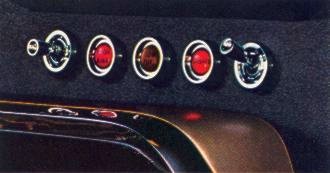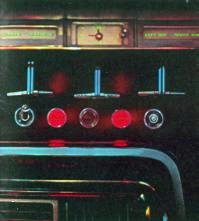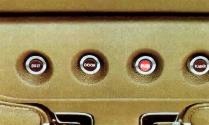| AUTO AUTHENTICITY: 1964-1971 Ford Thunderbird Safety-Convenience Control Panel (aka Convenience Check Group) |
|
  In 1964, Ford introduced a new option for the completely restyled Thunderbird.
Called the Safety-Convenience Control Panel (shown above), this new feature
was mounted on the clock housing, below the controls for the wiper and
washer, and the left and right air vents. Consisting of three round red
warning lights between two chrome toggle levers, the Safety-Convenience
Control Panel was a very useful option, and a popular one too.
From left to right was a toggle switch for the vacuum door locks, then a DOOR AJAR warning light that came on any time either door wasn't completely closed, as long as the ignition was on. After a few seconds, the light bulb started flashing to call additional attention to the fact a door wasn't securely closed. To the right of the door ajar light, located dead center in the middle of the panel, was a LOW FUEL warning light. This light illuminated when the fuel level in the gas tank fell below 3 1/2 to 4 gallons. The light would normally flicker for a period, as the car turned corners or hit bumps, but would eventually remain on steadily until the tank was filled up. To the right of the low fuel light were the FLASHER light and another chrome toggle control. The flasher light signified the front and rear turn indicators were flashing in unison, to warn oncoming traffic of the presence of a car. The toggle switch when pushed upward activated the flashers.  The Safety-Convenience Control Panel was heavily promoted in the 1964 Thunderbird
sales brochures, and in advertising. Not surprisingly, it was a big seller
and it's more usual to find Thunderbirds of this era so equipped, rather
than in their standard form. This trend continued into 1965, when the controls
were shuffled around to make them more convenient (shown at left). The
door ajar toggle switch and light switched places with the emergency flasher
switch and light. This made the door lock control more accessible to the
front seat passenger, and placed the flasher control closer to the driver,
since they'd normally be the only one using it. The Safety-Convenience Control Panel was heavily promoted in the 1964 Thunderbird
sales brochures, and in advertising. Not surprisingly, it was a big seller
and it's more usual to find Thunderbirds of this era so equipped, rather
than in their standard form. This trend continued into 1965, when the controls
were shuffled around to make them more convenient (shown at left). The
door ajar toggle switch and light switched places with the emergency flasher
switch and light. This made the door lock control more accessible to the
front seat passenger, and placed the flasher control closer to the driver,
since they'd normally be the only one using it.Ford thought this was such a selling point that in 1966 the Safety-Convenience Control Panel was made standard equipment on the Thunderbird Town Hardtop and Town Landau models. On just these two models, the warning lights were mounted overhead in a new roof console, and the vacuum door lock control was placed on the console below the Silent-Flo rear vent control in the area where the FASTEN SEAT BELTS reminder light was normally located, and the displaced seat belt light was moved up to the overhead console. For 1966, the option became somewhat diluted, since the emergency flasher system was made standard on all models. On cars not equipped with the convenience panel option, a single warning light and toggle switch were centered on the clock housing. The fact that it was standard equipment on most models made it one of the most popular options in the 1966 model year.  One might expect this trend to continue into 1967, but it did not. The
option, now a series of four round lights mounted over the windshield and
between the sun visors (shown at right), was further diluted by continuing
to include the flasher warning light as part of the optional Convenience
Check Group, as it was now called. Cars without this option had the turn
signal indicators on the instrument panel flash simultaneously, so having
a light in the Convenience Check Group also flash was somewhat redundant.
The seat belt reminder light was also included as part of this option on
all Thunderbird models, but the light itself was a standard feature on
all Thunderbirds, so again, people were paying extra for features that
were really standard. If you don't count the flasher and seat belt lights,
the Convenience Check Group consisted only of a low fuel warning light,
a door ajar warning light, and the vacuum door locks in 1967 and 1968. One might expect this trend to continue into 1967, but it did not. The
option, now a series of four round lights mounted over the windshield and
between the sun visors (shown at right), was further diluted by continuing
to include the flasher warning light as part of the optional Convenience
Check Group, as it was now called. Cars without this option had the turn
signal indicators on the instrument panel flash simultaneously, so having
a light in the Convenience Check Group also flash was somewhat redundant.
The seat belt reminder light was also included as part of this option on
all Thunderbird models, but the light itself was a standard feature on
all Thunderbirds, so again, people were paying extra for features that
were really standard. If you don't count the flasher and seat belt lights,
the Convenience Check Group consisted only of a low fuel warning light,
a door ajar warning light, and the vacuum door locks in 1967 and 1968.But what Ford taketh away, Ford also giveth: the new rolling door lock functionality was added for 1967 only. This item locked all doors automatically at 8 mph, and kept them locked until the car slowed to a speed below 8 mph. Great for people with small children in the back seat, and a great safety feature with the center hinged rear doors (called suicide doors by many). The rolling door lock feature alone made the optional check group worthwhile, but when this feature didn't return for the 1968 model year, it made the check group rather expensive for what you got. At $101.10 on a Fordor Thunderbird, it was pricey. You could order a power driver's seat for less, or throw in another $27 bucks and get the StereoSonic Tape System. Your chances of this option being on a 1967 or 1968 Thunderbird are pretty slim, and it's more unusual to see it on the cars that survive these days, it seems.  For 1969, and continuing through 1971, Ford modified the check group option
a bit by eliminating the flasher warning light and adding a new LIGHTS
warning light and buzzer. The emergency flashers now activated the instrument
panel lights, just like it had on cars without the check group option.
In its place the lights warning light came on and sounded a buzzer anytime
the driver's door was opened when the parking or headlights were on. For 1969, and continuing through 1971, Ford modified the check group option
a bit by eliminating the flasher warning light and adding a new LIGHTS
warning light and buzzer. The emergency flashers now activated the instrument
panel lights, just like it had on cars without the check group option.
In its place the lights warning light came on and sounded a buzzer anytime
the driver's door was opened when the parking or headlights were on.The buzzer was mounted behind the instrument panel, just to the left of the glove compartment, and it was an annoying little buzzer, too! In addition to being rather loud, it also had a very irritating tone to it, if you want to call the noise it makes a tone. One thing was for certain, though: with this option, there would be NO dead batteries due to lights being left on! The seat belt reminder light was still part of the check group, and it made sense that it would be a part of the warning lights since they were mounted up high where everyone in the car could see them easily. Popularity of this option increased somewhat in 1970 and 1971, although your chances of finding cars of these years so equipped these days are about 50/50. The vacuum door lock system became an "electro-vacuum" system in 1970, with electric solenoids replacing the vacuum valves that operate the lock motors. This increased the speed a bit, but vacuum was still somewhat slow to reach the rear door lock motors. After 1971, the Convenience Check Group ceased to be offered, and the various features of the option were split up and incorporated into other options, such as a Power Lock Group, or Convenience Light Group. Gone were the lights located over the windshield, which in retrospect seems like a very good place for them to be. Some car magazines of the time didn't think that was such a hot location, commenting that Ford was silly to expect someone who wasn't smart enough to check their fuel gauge to remember to look up at a warning light. Same goes for the lights on warning light. If they can't see the headlights on as they exit the car, how can anyone expect them to notice a little red light glowing up on the roof of the car? Of course, they were forgetting about that buzzer... Ford had a lot of better ideas, and we certainly think this was one of them! |
|